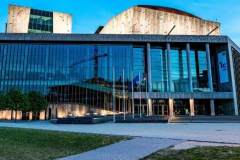Der Ring des Nibelungen 2026, 18-28 June
June 2026 | ||||||
|---|---|---|---|---|---|---|
Mo | Tu | We | Th | Fr | Sa | Su |
Der Ring des Nibelungen 2026, 18-28 June Includes Ticket for two different packages
18-21 June 2026
Das Rheingold (18 June 2026, 18:00-20:50), Die Walküre (19 June 2026, 16:00-22:00), Siegfried (20 June 2026, 16:00-22:05) and Götterdämmerung (21 June 2026, 16:00-20:30)
25-28 June 2026
Das Rheingold (25 June 2026, 18:00-20:50), Die Walküre (26 June 2026, 16:00-22:00), Siegfried (27 June 2026, 16:00-22:05) and Götterdämmerung (28 June 2026, 16:00-20:30)
Fans of Wagner have some important anniversaries to look forward to in 2026: It was 150 years ago in 1876 that the Ring cycle was first heard in its entirety in Bayreuth – with a Hungarian conductor, János Richter, on the podium. Meanwhile, Hungarian enthusiasts have been sharing in unforgettable moments at the Budapest Wagner Days for exactly 20 years. With each iteration, we relive the profoundly human story of gods and heroes in a staging by Hartmut Schörghofer that never fails to capture the imagination along with Ádám Fischer’s expert use of the conductor’s baton. Each year, the Müpa Budapest audience eagerly awaits the return of its favourite singers, so we have been welcoming Tomasz Konieczny back as Wotan from the very beginning. Other familiar faces are Jochen Schmeckenbecher’s Alberich, Jürgen Sacher’s Mime and Tijl Faveyts’s Fasolt. Norbert Ernst, who plays Loge, previously appeared at the Béla Bartók National Concert Hall in 2019 as the Scribe in Khovanshchina.
Program and cast
Das Rheingold
Artistic director and conductor: Ádám Fischer
Cast:
Wotan: Tomasz Konieczny
Donner: Zsolt Haja
Froh: Tibor Szappanos
Loge: Norbert Ernst
Fricka: Atala Schöck
Freia: Lilla Horti
Erda: Erika Gál
Alberich: Jochen Schmeckenbecher
Mime: Jürgen Sacher
Fasolt: Tijl Faveyts
Featuring:
the Hungarian Radio Symphony Orchestra
Creators:
dramaturgs: Christian Martin Fuchs, Dr. Christian Baier
costume and puppet design: Corinna Crome
revival director: Etelka Polgár
director: Hartmut Schörghofer
Die Walküre
Artistic director and conductor: Ádám Fischer
Cast:
Siegmund: Magnus Vigilius
Hunding: Albert Pesendorfer
Wotan: Tomasz Konieczny
Sieglinde: Magdalena Anna Hofmann
Fricka: Atala Schöck
Featuring:
the Hungarian Radio Symphony Orchestra
Creators:
dramaturgs: Christian Martin Fuchs, Dr. Christian Baier
costume and puppet design: Corinna Crome
revival director: Etelka Polgár
director: Hartmut Schörghofer
Siegfried
Artistic director and conductor: Ádám Fischer
Cast:
Mime: Jürgen Sacher
The Wanderer (Wotan): Derek Welton
Alberich: Jochen Schmeckenbecher
Erda: Erika Gál
Brünnhilde: Magdalena Anna Hofmann
Featuring:
the Hungarian Radio Symphony Orchestra
Creators:
dramaturgs: Christian Martin Fuchs, Dr. Christian Baier
costume and puppet design: Corinna Crome
revival director: Etelka Polgár
director: Hartmut Schörghofer
Götterdämmerung
Artistic director and conductor: Ádám Fischer
Cast:
Gunther: Birger Radde
Alberich: Jochen Schmeckenbecher
Hagen: Albert Pesendorfer
Gutrune: Lilla Horti
Waltraute: Dorottya Láng
Featuring:
the Hungarian Radio Symphony Orchestra
the Hungarian Radio Choir (choir master: Zoltán Pad)
Creators:
dramaturgs: Christian Martin Fuchs, Dr. Christian Baier
costume and puppet design: Corinna Crome
revival director: Etelka Polgár
director: Hartmut Schörghofer
Palace of Arts Müpa Budapest
When Müpa Budapest, Hungary and its capital's new cultural hub, opened in 2005, it was built to represent more than 100 years of Hungarian cultural history. As a conglomeration of cultural venues, the building has no precedent in 20th century Hungarian architecture and has no peers in the whole of Central Europe.
The creators of this ambitious project, the Trigránit Development Corporation, prime contractor Arcadom Construction and the Zoboki, Demeter and Partners Architectural Office, were driven by the desire to create a new European cultural citadel as part of the new Millennium City Centre complex along the UNESCO World Heritage-listed Danube waterfront. The result is a facility whose construction quality, appearance, functionality and 21st century technological infrastructure makes it ideally suited to productions of the highest standard. The building is also highly versatile and equipped to host performances of any genre and almost any scale.

 EN
EN DE
DE IT
IT FR
FR ES
ES RU
RU JP
JP RO
RO
 Seating plan
Seating plan 
